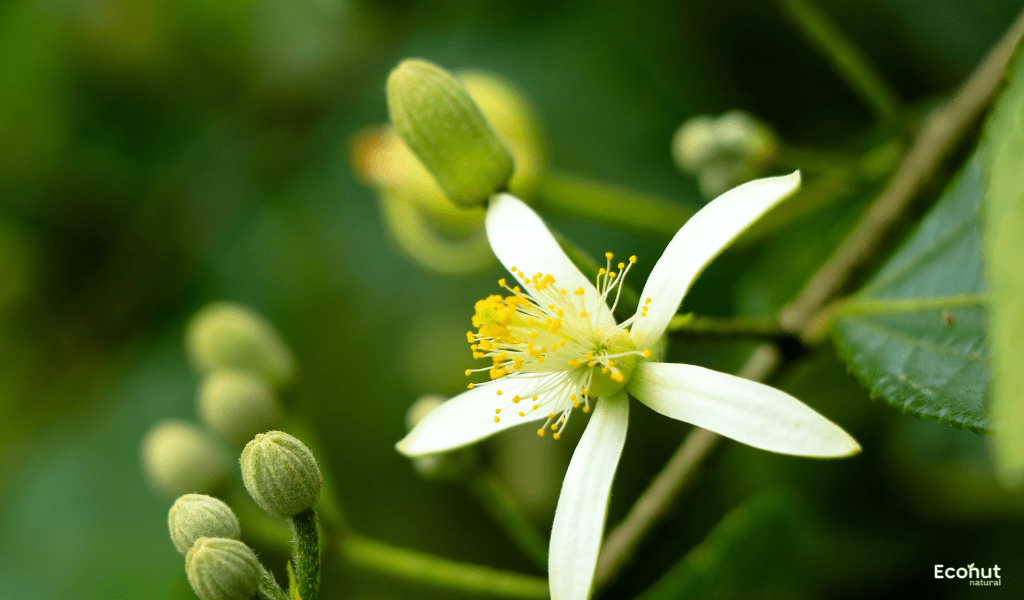Nagbala (Grewia hirsuta), is a tiny tree or shrub that grows in mixed deciduous open and dry evergreen forests. It is a member of the Malvaceae family. It is used as a nervine, brain tonic, antipyretic, diuretic, carminative, aphrodisiac, and cardiac tonic in folk and tribal medicine.
Nagbala (Grewia hirsuta) shrub reaches its flowering phase in June and July. This plant’s blossoms change color over time. They begin as white, gradually turn yellow, and eventually mature into brown. It is noteworthy that these flowers have globose-shaped buds.
Description
Nagbala (Grewia hirsuta) has hairy branches that are coarsely gray and brown in color. This plant produces 3 mm-long leaf stalks. The lance-shaped leaves measure 6–14 cm in length and 2-3.5 cm in width. When dried, these leaves have a blackish-brown hue. There are four to five pairs of lateral veins in each leaf, and the lateral basal veins are as long as the leaf blade.
Botanical Name:
Grewia hirsute
Family:
Malvaceae
Leaves:
The Nagbala plant has ovate or cordate leaves with serrated edges and pointy points. They have a petiole-the stalk that joins the leaf to the stem—and are only sporadically hairy.
Flowers:
The most striking feature of the Nagbala blossoms is their white hue.
Roots:
The Nagbala plant has robust, well-developed roots. They are said to possess the highest level of therapeutic potency inside the plant.
Habitat:
Grewia hirsute, commonly referred to as Nagbala, is a tiny tree or shrub that grows in mixed deciduous open and dry evergreen forests.
Parts Used:
- Roots
- Fruits
- Leaves
Dosage:
- 3 – 5 Grams
Chemical Constituents
The plant is reported to contain flavonol (kaempferol), alkaloids, anthraquinones, tannins, glycosides, phenolics (vanillic, syringic, melilotic, p-hydroxy benzoic, and protocatechuic acids), and steroids.
Sanskrit Synonyms
Gangeruki, Vishvadeva, Hrasva Gavedhuka, Kharandhika, Khanda,
Other Language Names of Nagbala (Grewia hirsuta)
Gujarati name – Gangesada, Gangeruki
Bengali name – Khanta Kari, Chirata
Sanskrit name – Gudachi, Phalsa, Khantakari
Hindi name – Kukurbicha, Gankura, Dhaman
Marathi name – Dhavan, Phalsa
Tamil name – Nellikathalai, Thaali
Telugu name – Jetukamu, Nagaballi
Scientific Classification
| Kingdom | Plantae |
| Phylum | Tracheophyta |
| Class | Magnoliopsida |
| Order | Malvales |
| Family | Malvaceae |
| Genus | Grewia |
| Species | Grewia hirsute |
Ayurvedic Properties
Rasa (Taste) – Madhura (sweet)
Guna (Qualities) – Guru (heaviness), Picchila (slimmy), Snighda (oily)
Veerya – Sheeta (Coolant)
Vipaka – Madhura (Sweet taste after digestion)
Nagbala (Grewia hirsuta) Uses
- The root and fruits of Nagbala are useful in the treatment of acute diarrhea, dysentery, and urinary issues.
- Crushed Nagbala (Grewia hirsuta) roots and leaves combined with sugar make a useful remedy for spermatorrhoea.
- The fruit juice from Nagbala is good for curing dyspepsia.
- Nagbala leaves can be used to treat rheumatism, joint pain, breast soreness, splenic enlargement, and problems of the nose and eyes.
- The paste of Nagbala leaves is administered topically to boils, and the paste of Nagbala roots is applied topically to wounds and cuts.
Nagbala (Grewia hirsuta) Benefits
Controls Diarrhea:
Use Nagbala if you are experiencing diarrhea; it works well to halt it. Experts advise consuming the powdered fruit and root of Nagbala when suffering from diarrhea. When consumed, it also relieves dysentery.
diabetis:
nagbala may support blood sugar regulation.
Nagbala inhibits the growth of the spleen:
Nagbala inhibits the growth of the spleen by its therapeutic effects. Make a paste out of the Nagbala leaves and either eat them or leave them on the spleen part to gently warm it. This helps with the issue of splenic enlargement.
Helps in Piles:
Nagbala is thought to be helpful when dealing with piles. It relieves piles and resolves the constipation issue. In piles, drinking its decoction or powder is helpful.
Nagbala helps with tuberculosis treatment:
Nagbala has therapeutic qualities that make TB treatment easier. Consume powdered Nagbala root along with ghee and honey every morning. Combine equal parts barley, ashwagandhamul, sesame, jaggery, and urad powder; consume one serving each day in the morning with milk. It boosts physical strength and helps with tuberculosis.
Cold and Cough:
People frequently get sick from the cold as a result of weather variations or after consuming cold items. You can get rid of the cold with the aid of a few Ayurvedic home remedies. Nagbala can also help you recover from the flu and cold. Use the juice from the Nagbala leaves in your nose and eat the leaves for this.
Solves problem of nose and ear bleeding:
Many people begin to experience difficulties with bleeding from their ears and nose in the summer. This issue is known in Ayurveda as Rakta Pitta. Nagbala can be used to cure it. Taking Nagbala powder combined with honey solves this issue.
Don’t miss: Hing (Ferula narthex) – Uses, Benefits & Side Effects
Nagbala (Grewia hirsuta) Side Effects
Pregnant and breastfeeding women:
The safety of nagbala for women who are pregnant or nursing is not well enough understood. Be cautious and steer clear of utilizing it at all costs.
People with certain medical conditions:
Nagbala may exacerbate specific medical conditions or interact negatively with some drugs. If you have any health concerns, it’s crucial to discuss these with your doctor before beginning nagbala treatment.
Conclusion
The herb nagbala, also called Grewia hirsuta, has long been used in traditional medicine. There hasn’t been much scientific research done on it, but it seems promising for several medical issues. This is an overview of its possibilities:
FAQS
What advantages does nagabala offer?
Aphrodisiac, carminative, expectorant, demulcent, anti-acidic, antipyretic, and diuretic are just a few of the many benefits of naga bala. Dysuria and bleeding disorders are treated with it. It is an anti-aging and aphrodisiac herb. This herb is very helpful in treating dysuria and bleeding issues.
What is the chemical composition of Nagbala?
The stem of Grewia Hirsuta is dried and powdered to produce ẞ-sittosterol, a-amyrin, ẞ-amyrine, and foradol. This plant’s aqueous extract includes glutamic acid, serine, proline, phenylalanine, isoleucine, and lysine.
Which family belongs to Grewia Hirsuta?
Asian flowering plant species Grewia hirsuta belongs to the Malvaceae family of plants.

